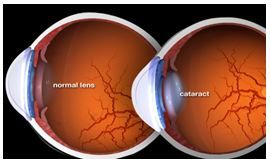Cataract & Phacoemulsification
Cataract is basically a cloud in your vision or, in simple words, blurry vision. This eye disease causes disruption of light into the retina, creating images like looking through an opaque glass. The most common symptom of a cataract is blurred vision. Other symptoms may include faded colors, poor night vision, halos around lights, double vision in one eye, and frequent changes in eyeglass or contact lens prescriptions. If you’re experiencing these symptoms, visiting the best cataract hospital in Ambala can provide you with expert diagnosis and advanced treatment options to restore your clear vision.

Cataract is the leading cause of blindness in the world. It is a clouding of the eye’s natural lens, which lies behind the iris and the pupil. While cataract is most common in older adults, it can occur at any age. It can cause blurry vision, double vision, halos around lights, and sensitivity to light and glare. If you or a loved one is experiencing these symptoms, it’s essential to seek care from the Best Cataract Hospital in Ambala & Haryana for expert diagnosis and treatment.
Cataracts are caused by a buildup of proteins in the eye’s lens that can cause it to cloud over and block light from reaching the retina. While doctors don’t know exactly what causes the buildup of proteins, they believe it is the result of aging and the exposure of the eyes to ultraviolet light. Regular eye check-ups at the Best Cataract Hospital in Ambala & Haryana can help detect cataracts early and prevent further vision deterioration.
The most common treatment for cataracts is surgery. Cataract surgery involves removing the cloudy lens and replacing it with an artificial intraocular lens (IOL). This procedure is usually done on an outpatient basis and takes about 5 minutes. After the surgery, patients may need to wear glasses or contact lenses to improve their vision. For safe and effective cataract surgery, trust the experienced specialists at the Best Cataract Hospital in Ambala & Haryana, where advanced technology and compassionate care ensure the best outcomes for patients.
Cataract are caused by a buildup of proteins in the eye’s lens that can cause it to cloud over and block light from reaching the retina. While doctors don’t know exactly what causes the buildup of proteins, they believe it is the result of aging and the exposure of the eyes to ultraviolet light.
The most common treatment for cataract is surgery. Cataract surgery involves removing the cloudy lens and replacing it with an artificial intraocular lens (IOL). This procedure is usually done on an outpatient basis and takes about 5 minutes. After the surgery, patients may need to wear glasses or contact lenses to improve their vision. For the best care and results, it is recommended to visit the Best Cataract Hospital in Ambala, where experienced specialists ensure a safe and effective treatment process.

Symptoms of Cataract
Progressive blurry image is the quite general symptom moreover person suffering from this problem faces focus problem while driving and doing other daily work reading, writing, watching TV to name a few each and every thing that demands clear vision.
There is no medication, exercise or eye drops to stop and eliminate cataract, surgery is the only option.
Phacoemulsification Procedure
Phacoemulsification, also known as “phaco” or “small incision cataract surgery,” is a minimally invasive surgical technique used to remove cataracts from the eye. During the procedure, an ultrasonic probe is inserted into the eye, which emits sound waves to break up the cataract into tiny pieces. The fragments are then suctioned out of the eye. Trust the Best Cataract Hospital in Ambala for cutting-edge cataract treatment and exceptional eye care.
The procedure is performed under topical (eye drop) anesthesia and usually takes around 5 minutes, including pre- and post-operative care. The patient typically experiences minimal discomfort and can return home within a few hours after the procedure.
The primary benefit of phacoemulsification is that it is a minimally invasive technique, which means that it requires no sutures or stitches. This reduces the risk of infection and other post-operative complications. Additionally, small incision cataract surgery offers improved vision and a quicker recovery time than traditional cataract surgery.
At Kapil Eye Hospital, we specialize in advanced cataract treatments, making us the trusted choice for patients seeking the Best Cataract Hospital in Ambala & Haryana.
In order to ensure optimal results, it is important for patients to choose an experienced eye surgeon. A qualified ophthalmologist will be able to provide an individual assessment of the patient’s condition and provide guidance on the best treatment option.
Via incision a micro instrument is inserted into the eye that vibrates forty thousand times a second resulting breakage of the cataract into tiny pieces. After this phase these small pieces are sucked out of the eye and replaced with a new artificial lens. No stitches are required in this case and healing is quick. Usually within 5 days you can get back to your daily chores.
Kapil Eye Hospital – Best Cataract Hospital in Ambala & Haryana – provides advanced eye care tailored to your needs. Your doctor will recommend the best treatment option suitable for your condition, ensuring safe and effective results. Trust our expertise for world-class cataract surgery and personalized care.
Benefits :-
- No Stitches
- No Pain
- No Injection
- Safe
- No Cloudy Glance
- Highly Accurate
- Recovery Time 4-7 Days
- Enhanced Contrast & Focus
- Long lasting outcome
- Very higher rate of success
- Not a prolonged surgery

